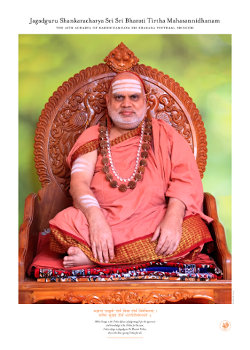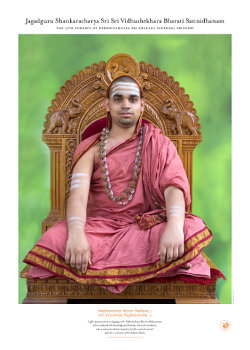“OM Sree Gurubhyo Namaha”.
At the outset, I start with pranams to Jagadguru Sankaracharya His Holiness Sri Sri Sri Bharathi Theertha Mahaswamigal, the ruling and 36th Pontiff and His successor designate Jagadguru Sankaracharya His Holiness Sri Sri Sri Vidhu Shekhara Bharathi swamigal the 37th Pontiff of Sri Sringeri Saradha Peetham for everyone’s welfare & continued prosperity.


Gita and Ganga constitute the essence of Hinduism; one is theory and the other its practice.” - Swami Vivekananda
 |
| River Ganges - Hari pauri ghat |
Our last leg of the tour brought us to Haridwar and Rishikesh. We went to Rishikesh first and as we traversed the holy cities, it is the River Ganges all the way in the form of River,tributary and canals. An over-whelming feeling pervades the atmosphere both internal and external. Sitting on the banks of Ganga, when I reflected for few moments in silence, the first thoughts that came to me were.
The river Ganges has seen the past of our generations from time immemorial, is guiding us in the present and will be there in the future with our succeeding generations.
 |
| Rudraksha Tree |
 |
| Lakshman Jhula |
We went to 'Lakshman temple' and I understand this is the place Lord Sri Lakshman bestows his blessing and grace in an unique manner. In other temples elsewhere the Idols are always with Rama and Sita. Lord Lakshmana did severe penance and followed strict austerities here on the banks of river Ganges for 12 years in order to free himself from 'Brahmahathi Dhosa'after killing Indrajit (Meghdooth) the son of Ravana. ( Brahmahathi Dhosa - A sin that accrues after killing a Vedic Brahmin or Sacred cow. Doing severe penance, tapas, Japa, homa and wearing of Eka Mukhi Rudraaksha are believed to help a person to get rid of this sin. The causal effect of the sin is endless cycles of re-birth )
We spent some time in Lakshman Jhula and moved to the next hop.
 |
| Ganga Arthi Bhajans in Paramartha Nikethan Ashram |
 |
| Paramartha Nikethan Ashram |
 |
| Devotees Offering floral Thanks to River Ganges |
In Rishikesh, we participated in 'Ganga Arthi' from the precincts of Paramatha Niketan ashram. I was very impresssed by the social work done by this ashram. The most notable being the 'Bio- toilets' done in participation with our Indian premier research organization DRDO, whcih is the need of the hour. Melodious and Heart-rendering bhajans were sung by devotees and a Yagna ( Fire ritual ) performed as a thanks-giving to River Ganges for all that she ahs done. This ritual is conducted every day and many foreign devotees also participate and perform the yagna. For a congregation of about 500 people hardly 5-6 floral plates were offered to the river.
( Thanks to the ashram for this cleanliness, as unmindful dumping of flowers into river Ganges is also a main source of pollution in the down-streams - We noticed this in Haridwar)
 |
| Hari Pauri Ghat - Haridwar |
 |
| Maya Devi temple - Haridwar |
Myself and Dev took a long and fast paced walk to Maya devi temple. The interesting, aspect was when we enquired the way, everyone said, it is 10 mins from that point and the same was repeated in the next hop on further inquiry, and the 10 mins seemed an endless walk in the narrow and intertwining lanes. I brought back 'Ganga Jal' (water) in a big bottle and handed over for pooja in a nearby temple. The Ganga jal was used to perform abhishekam for lord Shiva in the subsequent 'Pradhosha pooja' in the nearby temple and I also participated. I felt immensely happy :-)
 |
| Devotees tonsuring their Hair in fulfillment of prayers |
 |
| River Ganges |
I have not penned down much on Haridwar and Rishikesh as lot of content is available on the web and I do not want to duplicate myself
The request i have for the blog readers are two fold:
1) Some of these places like Haridwar and Rishikesh are physically challenging . In a huge country like us with 1.2 billion people and good amount of disposable income these historically and religiously important places are perennially crowded. Visit these places when you are young and energetic and do not procrastinate. When we are aged, the Spirit may be willing, but not the flesh
2) All of us took a vow to keep all our rivers clean and we request you to do the same.
And, that ends my interesting saga for our visit to Ninital, Binsar, Corbett , Haridwar and Rishikesh. Hope you enjoyed as well.

















































